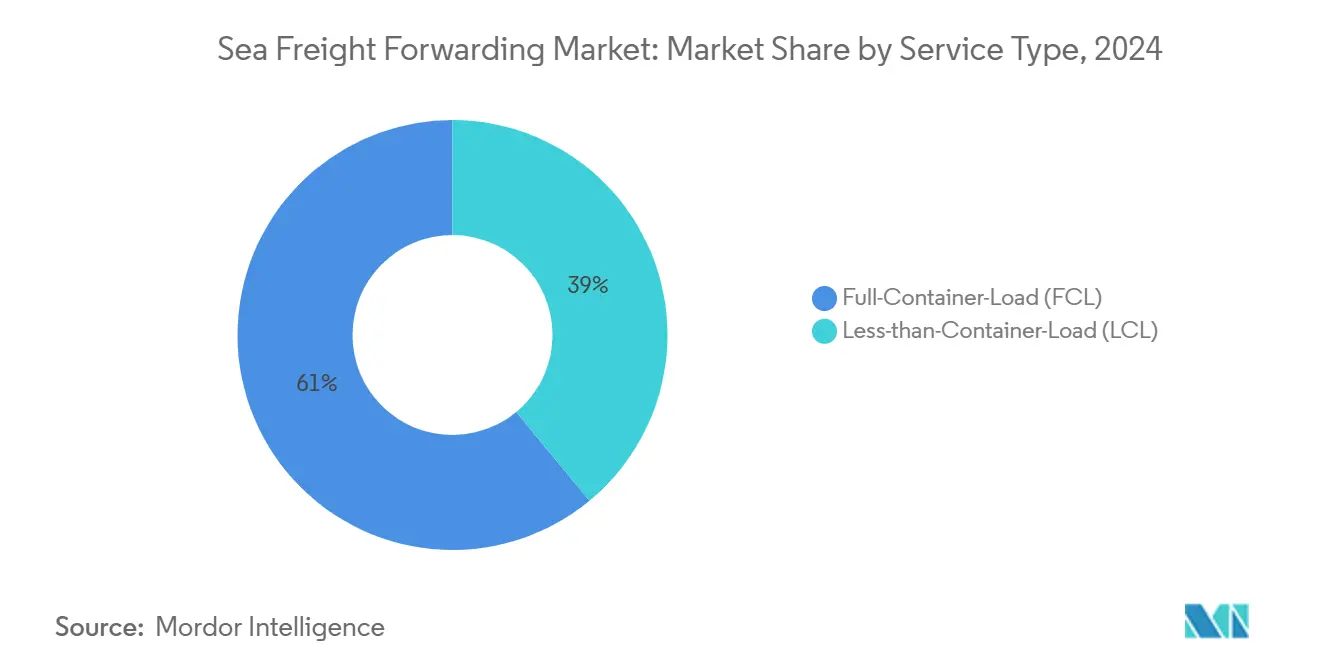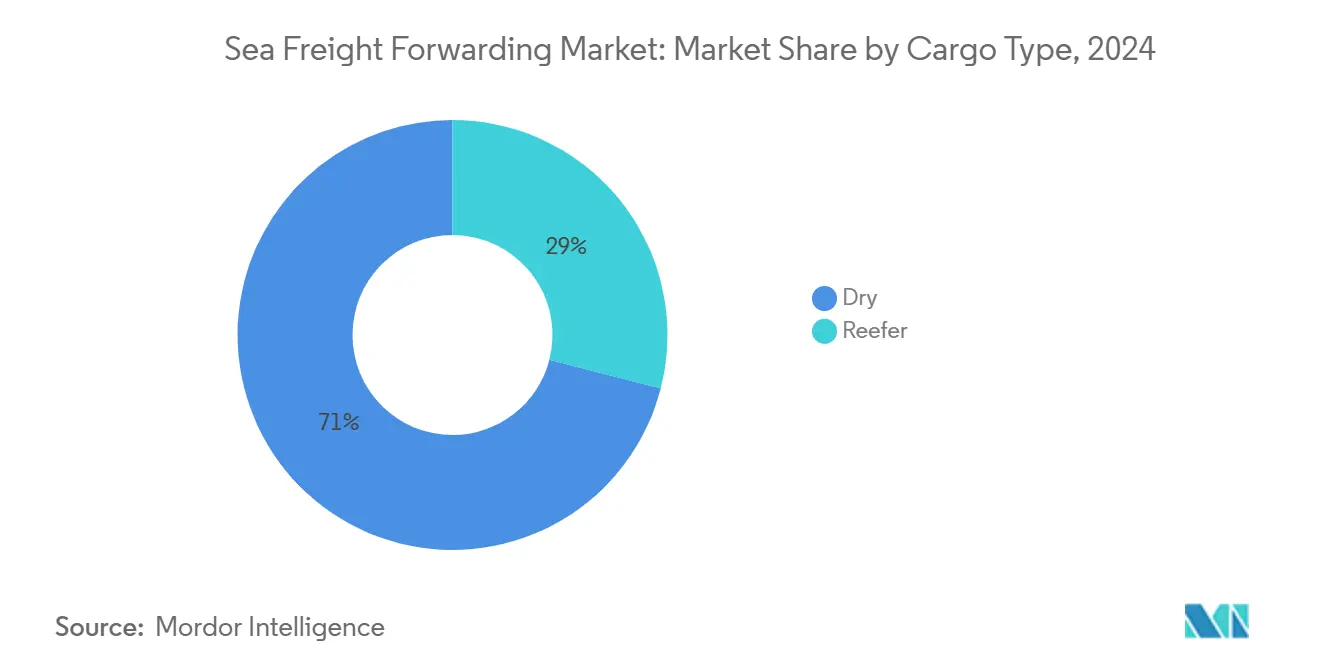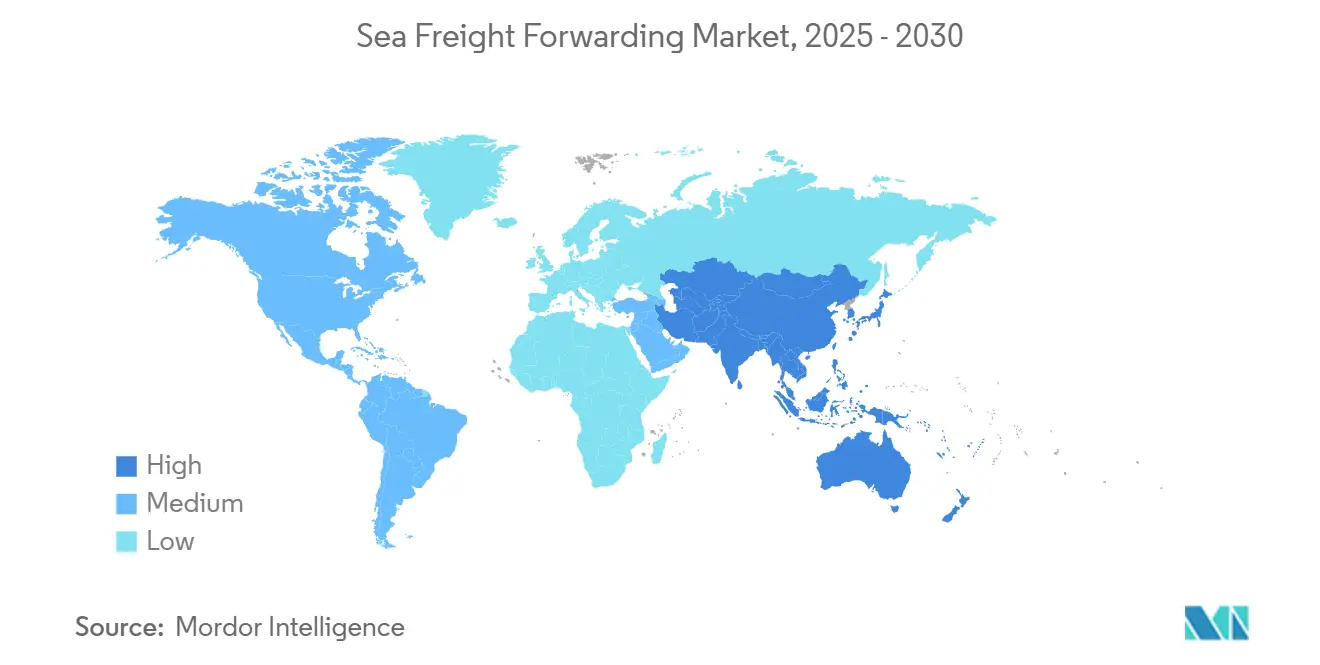Sea Freight Forwarding Market Size and Share

Sea Freight Forwarding Market Analysis by Mordor Intelligence
The Sea Freight Forwarding Market size is estimated at USD 358.31 billion in 2025, and is expected to reach USD 465.66 billion by 2030, at a CAGR of 5.38% during the forecast period (2025-2030).
Robust earnings at container lines, the march toward digital booking standards, and a global pivot from just-in-time to just-in-case inventory strategies underpin this outlook. Merchant-fleet capacity additions, fresh port investments, and e-commerce–linked shipment fragmentation are widening the opportunity set for service providers that can guarantee space, speed, and visibility. Alliances controlling 80% of container capacity have announced new operating structures that take effect in 2025, further tightening schedule coordination and slot utilization. Yet the arrival of 478 new boxships in 2024 outpaced demand, pressuring spot rates and handing shippers negotiating leverage[1]“Final Versions of Booking 2.0 and Bill of Lading 3.0,” Digital Container Shipping Association, dcsa.org.
Key Report Takeaways
- By service type, Full-Container-Load held 61.0% of the sea freight forwarding market share in 2024, while Less-than-Container-Load is projected to advance at 4.70% CAGR through 2030.
- By cargo type, Dry Cargo commanded 71.0% share of the sea freight forwarding market size in 2024; Reefer Cargo is poised to expand at 4.10% CAGR to 2030.
- By end-user, Retail & E-commerce captured 25.0% share of the sea freight forwarding market size in 2024, whereas Pharmaceuticals & Healthcare registers the highest growth at 5.20% CAGR to 2030.
- By geography, Asia-Pacific accounted for 41.0% of the sea freight forwarding market share in 2024 and is growing at 5.10% CAGR through 2030.
Global Sea Freight Forwarding Market Trends and Insights
Drivers Impact Analysis
| Driver | % Impact on CAGR Forecast | Geographic Relevance | Impact Timeline |
|---|---|---|---|
| Container-port capacity additions | +1.2% | Asia-Pacific; North America | Medium term (2-4 years) |
| Cross-border e-commerce fulfillment scaling | +0.9% | North America; Europe; Asia-Pacific | Short term (≤ 2 years) |
| Carrier digital booking platforms and APIs | +0.6% | Developed markets worldwide | Short term (≤ 2 years) |
| Near-shoring of battery-grade raw materials | +0.8% | North America; Europe; Asia-Pacific | Long term (≥ 4 years) |
| Decarbonization-driven CO₂-audited logistics | +0.7% | Europe; North America; Asia-Pacific | Medium term (2-4 years) |
| Parametric maritime-insurance roll-out | +0.4% | High-value trade lanes | Medium term (2-4 years) |
| Source: Mordor Intelligence | |||
Surge in container-port capacity additions 2025-2030
China’s top eight gateways lifted 224 million TEU in 2024, up 7%, while Shanghai crossed 50 million TEU, cementing its rank as the world’s busiest container port. Major U.S. hubs also broke throughput records; the Port of Los Angeles hit 10.3 million units and is investing in zero-emission yard gear. New megaprojects at Nansha, Chancay, and Tuas promise to reset sailing patterns, intensifying competition among freight forwarders for volume commitments. Parallel fleet growth-478 deliveries in 2024 alone hands shippers more slot choice, enabling forwarders to bargain harder for rates.
Rapid scaling of cross-border e-commerce fulfillment networks
Global retail e-commerce sales are tracking toward USD 8 trillion by 2027, producing a wave of parcel-sized ocean consignments. Walmart’s “port-to-door” service has already cleared 1,988 TEU for marketplace sellers, exemplifying how major retailers are internalizing logistics. Forwarders embracing application-program-interface connectivity can batch disparate seller orders into cohesive Less-than-Container-Load solutions, trimming dwell time and customs friction.
Widespread carrier digital booking platforms and API connectivity
DCSA’s Booking 2.0 and e-BL 3.0 frameworks, released in 2025, codify data fields and digital-signature protocols needed for a paperless transaction flow. Early adopters such as Neele-Vat Ocean report faster booking cycles after integrating Coneksion’s RAPIDS solution. Singapore’s digitalOCEANS platform displays the power of port-authority-led orchestration, cutting administrative steps and emissions.
Growing near-shoring of battery-grade raw materials
Clean-energy stimulus is drawing cathode and anode material processing closer to North-American and European cell plants. China imported 171.6 million tons of bauxite in 2024, but Western smelters are mobilizing to shorten supply lines. Deep-sea nodules under exploration contain cobalt and nickel quantities that may rewrite sourcing maps. Forwarders versed in IMO-DG rules for lithium compounds gain pricing power in this niche.
Restraints Impact Analysis
| Restraint | % Impact on CAGR Forecast | Geographic Relevance | Impact Timeline |
|---|---|---|---|
| Fuel-surcharge freight-rate volatility | -0.8% | Global long-haul lanes | Short term (≤ 2 years) |
| Carrier vertical integration | -0.6% | Global, mid-tier forwarders | Medium term (2-4 years) |
| Legacy TMS cyber-risk exposure | -0.4% | Digitally intensive markets | Short term (≤ 2 years) |
| Canal-route geopolitical disruptions | -0.7% | Europe-Asia corridors | Short term (≤ 2 years) |
| Source: Mordor Intelligence | |||
Freight-rate volatility linked to IMO 2023 fuel-sulfur cap surcharges
Very-Low-Sulfur Fuel Oil averaged USD 608 per ton in 2024; ETS levies will add USD 170-210 per ton for voyages touching European waters from 2025. Bunker Adjustment Factors jumped to USD 623 per FEU on Asia-USWC contracts, consuming 37% of all-in rates. Forwarders must hedge or pass through surcharges, a delicate balancing act in competitive bid cycles.
Ocean-carrier vertical integration squeezing independent forwarder margins
DSV’s USD 15.95 billion takeover of DB Schenker vaults the combined entity to USD 42.86 billion in revenue and nearly 160,000 staff, recalibrating the power balance in large tenders DSV. Maersk, MSC, and CMA CGM keep redirecting pandemic-era windfalls into integrated logistics, arming them with the ability to bundle ocean space with end-to-end fulfillment at cut-rate margins. Independent forwarders are countering by specializing in pharmaceuticals, project cargo, or trade-compliance advisory where carrier propositions remain thin.
Segment Analysis
By Service Type: FCL dominance drives consolidation trends
Full-Container-Load shipments secured 61.0% of the sea freight forwarding market in 2024, upholding their status as the workhorse for manufacturers that frontloaded inventory during pandemic bottlenecks. The sea freight forwarding market size for FCL is forecast to climb alongside port-capacity projects and alliance network revamps. Conversely, Less-than-Container-Load, though smaller, benefits from a 4.70% CAGR as e-commerce sellers lean on LCL consolidations to maintain SKU availability. The sea freight forwarding market share of LCL will inch higher as API-linked booking platforms simplify cargo co-loading and customs pre-clearance steps[2]“Container Shipping Profits in 2024, Uncertain Outlook for 2025,” Cluster Collaboration, clustercollaboration.eu.
Digital quoting tools now surface optimal FCL vs. LCL decisions in seconds, nudging mid-volume shippers toward the most cost-efficient mode per sailing. Consolidators that guarantee 48-hour container stuffing windows and electronic House Bills are attracting B2C platforms that ship direct to consumer. As volatility lingers in spot indexes, FCL contract mechanisms featuring bunker float clauses and carbon-intensity adjustments will shape rate ceilings for 2025 tenders, reinforcing the pricing sophistication gap between scale players and smaller brokers.

By Cargo Type: Reefer growth accelerates cold-chain expansion
Dry Cargo retained 71.0% share in 2024 and occupies the largest sea freight forwarding market size segment thanks to steady flows of finished goods and industrial inputs. The sea freight forwarding market share of Reefer Cargo, however, is set to rise from its lower base as temperature-sensitive commodities gain prominence. Reefer volumes are advancing at 4.10% CAGR on the back of soaring pharmaceutical traffic; cold-chain drugs touched USD 21.3 billion in logistics spend during 2024.
Ocean carriers now promote Controlled-Atmosphere reefers equipped with IoT probes that feed lane-specific stability data into Good-Distribution-Practice dashboards OOCL. Spot reefer freight rates trail air by 70-80%, incentivizing vaccine makers to shift lanes once qualification audits pass. Meanwhile, dry-cargo trade tied to electric-vehicle battery inputs such as bauxite and copper concentrate underpins base-load demand, providing carriers with backhaul potential into China’s smelting clusters.

By End-User Industry: Pharmaceutical logistics drives premium growth
Retail & E-commerce commanded 25.0% of 2024 demand and remains the largest consumer of forwarding services as marketplaces globalize. Yet Pharmaceuticals & Healthcare outpaces all peers at a 5.20% CAGR to 2030, reflecting stringent temperature and handling protocols that lift gross yields. Electronics & Semiconductors traffic derives strength from data-center server clusters and photovoltaic components, both essential to the USD 2 trillion clean-tech economy forecast for 2035 IEA.
Forwarders that secure GDP-compliant facilities and ISO 13485 certifications can charge service premiums. Meanwhile, chemicals shippers capitalize on new near-shored processing hubs needing multimodal drayage to coastal gateways. Across user segments, the sea freight forwarding market continues to fragment into value-added niches where regulatory knowledge and real-time tracking trump pure scale.
Geography Analysis
Asia-Pacific generated 41.0% of 2024 revenue and posts a regional 5.10% CAGR to 2030, buoyed by Chinese exports, Southeast-Asian near-sourcing, and intense intra-Asian trade. Shanghai’s record 50 million TEU milestone and South-China’s Nansha expansion give forwarders abundant sailings to fill.
North America saw combined import volumes at its top ports jump 13% to 28.2 million TEU in 2024, aided by restocking in consumer durables AJOT. The sea freight forwarding market size tied to U.S.‐Mexico near-shoring corridors is swelling, especially for automotive, electronics, and battery supply chains[3]“Average Operating Margins for the Leading Container Carriers Breached 20% in Q2 2024,” Global Maritime Hub, globalmaritimehub.com.
Europe wrestles with Suez detours that add 10-14 days to Asia rotations; traffic is still 57% below peak despite toll breaks. Carbon-footprint auditing, mandated by the EU-ETS and FuelEU Maritime rules, emerges as a service differentiator.
Middle East & Africa benefits from giga-projects across the Gulf and Horn of Africa corridor upgrades. Breakbulk and project forwarders anticipate wind-turbine and refinery modules to dominate outbound charters. South America leverages its neutrality to court diversification trade; Panama Canal set a 1,200-transit record in the January-May 2025 window, cementing its gateway role.

Competitive Landscape
The market is fragmented. DSV’s purchase of DB Schenker secures extra contract sway with global enterprise shippers and signals a continued appetite for mega-mergers DSV. Kuehne+Nagel remains the single largest ocean forwarder at 4.3 million TEU and is broadening North-American drayage via a 51% IMC Logistics stake.
Technology-centric challengers such as Forto and Flexport invest heavily in real-time visibility dashboards, pressuring incumbents to digitize legacy processes. Carriers’ in-house logistics arms, led by Maersk Logistics & Services, multiply the competitive set. Profit margins gravitate toward specialty lanes pharmaceutical, defense, high-tech where compliance and chain-of-custody disciplines deter commoditization. As scale matures, capital allocation shifts toward inland warehousing networks and AI-driven yield-management systems designed to match shippers with under-utilized capacity in carrier alliance loops.
Sea Freight Forwarding Industry Leaders
-
Kuehne + Nagel
-
DHL Global Forwarding
-
Sinotrans
-
DSV A/S
-
Expeditors International
- *Disclaimer: Major Players sorted in no particular order



Recent Industry Developments
- April 2025: DSV completed its EUR 14.3 billion (USD 15.78 billion) acquisition of DB Schenker, forming the world’s largest forwarder with projected EUR 41.6 billion (USD 48.32 billion) revenue.
- March 2025: Radiant Logistics bought Transcon Shipping, adding Los Angeles, New York, and Chicago gateways.
- February 2025: DCSA issued Booking 2.0 and e-BL 3.0 digital-exchange standards.
- January 2025: Blue Logistics Group acquired Rhenus Denmark’s air and sea units, entering pharma logistics.
Global Sea Freight Forwarding Market Report Scope
Sea Freight Forwarding is a method of transporting large quantities of goods using cargo ships where goods are packed in containers and loaded onto ships. A typical freighter can carry about 18,000 containers, making ocean freight a cost-effective way to transport large quantities over long distances.
The Sea Freight Forwarding Market report provides insights into the market Market Overview, Market Dynamics, Value Chain / Supply Chain Analysis, Technological Trends, Investment Scenarios, Government Regulations and Initiatives, Sea Freight Transportation Costs/Freight Rates, Insights on the E-commerce Industry, on the Sea Freight Forwarding Market and Industry Attractiveness. Furthermore, the report also provides company profiles with leading market players to understand the market's competitive landscape.
The Sea Freight Forwarding market is segmented by Type (FCL, LCL, and Other Types) and Geography (North America [United States, Canada, and Mexico], Europe [Germany, France, Netherlands, United Kingdom, Italy, and the Rest of Europe], Asia-Pacific [China, Japan, Australia, India, Singapore, Malaysia, Indonesia, South Korea, and Rest of Asia-Pacific], Middle-East and Africa [South Africa, Egypt, GCC Countries, Rest of Middle-East and Africa], and South America [Brazil, Chile, and Rest of South America]). The report offers the market size in value terms in (USD) for all the abovementioned segments.
| Full-Container-Load (FCL) |
| Less-than-Container-Load (LCL) |
| Dry |
| Reefer |
| Electronics and Semiconductors |
| Chemicals and Petrochemicals |
| Food and Beverage |
| Pharmaceuticals and Healthcare |
| Retail and E-commerce |
| Others |
| North America | United States |
| Canada | |
| Mexico | |
| South America | Brazil |
| Peru | |
| Chile | |
| Argentina | |
| Rest of South America | |
| Asia-Pacific | India |
| China | |
| Japan | |
| Australia | |
| South Korea | |
| South East Asia (Singapore, Malaysia, Thailand, Indonesia, Vietnam, and Philippines) | |
| Rest of Asia-Pacific | |
| Europe | United Kingdom |
| Germany | |
| France | |
| Spain | |
| Italy | |
| BENELUX (Belgium, Netherlands, and Luxembourg) | |
| NORDICS (Denmark, Finland, Iceland, Norway, and Sweden) | |
| Rest of Europe | |
| Middle East and Africa | United Arab of Emirates |
| Saudi Arabia | |
| South Africa | |
| Nigeria | |
| Rest of Middle East And Africa |
| By Service Type | Full-Container-Load (FCL) | |
| Less-than-Container-Load (LCL) | ||
| By Cargo Type | Dry | |
| Reefer | ||
| By End-User Industry | Electronics and Semiconductors | |
| Chemicals and Petrochemicals | ||
| Food and Beverage | ||
| Pharmaceuticals and Healthcare | ||
| Retail and E-commerce | ||
| Others | ||
| By Geography | North America | United States |
| Canada | ||
| Mexico | ||
| South America | Brazil | |
| Peru | ||
| Chile | ||
| Argentina | ||
| Rest of South America | ||
| Asia-Pacific | India | |
| China | ||
| Japan | ||
| Australia | ||
| South Korea | ||
| South East Asia (Singapore, Malaysia, Thailand, Indonesia, Vietnam, and Philippines) | ||
| Rest of Asia-Pacific | ||
| Europe | United Kingdom | |
| Germany | ||
| France | ||
| Spain | ||
| Italy | ||
| BENELUX (Belgium, Netherlands, and Luxembourg) | ||
| NORDICS (Denmark, Finland, Iceland, Norway, and Sweden) | ||
| Rest of Europe | ||
| Middle East and Africa | United Arab of Emirates | |
| Saudi Arabia | ||
| South Africa | ||
| Nigeria | ||
| Rest of Middle East And Africa | ||


Key Questions Answered in the Report
What is the current value of the sea freight forwarding market?
The market is valued at USD 358.31 billion in 2025.
How fast is the sea freight forwarding market expected to grow?
It is projected to expand at a 5.38% CAGR from 2025 to 2030.
Which service type holds the largest share in sea forwarding?
Full-Container-Load services account for 61.0% of 2024 volume.
Which cargo type is growing the fastest?
Reefer Cargo is rising at 4.10% CAGR through 2030, fueled by pharmaceutical demand.
Which region leads sea freight forwarding revenues?
Asia-Pacific commands 41.0% of 2024 revenues and remains the fastest-growing region.
What recent mega-deal reshaped the competitive landscape?
DSV’s EUR 14.3 billion (USD 15.78 billion) acquisition of DB Schenker finalized in April 2025.
Page last updated on:









